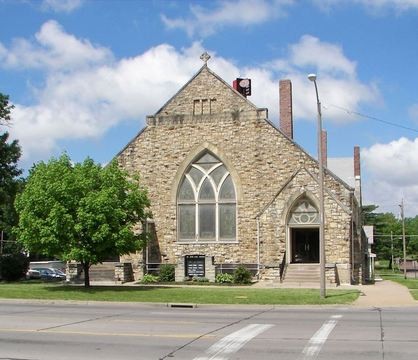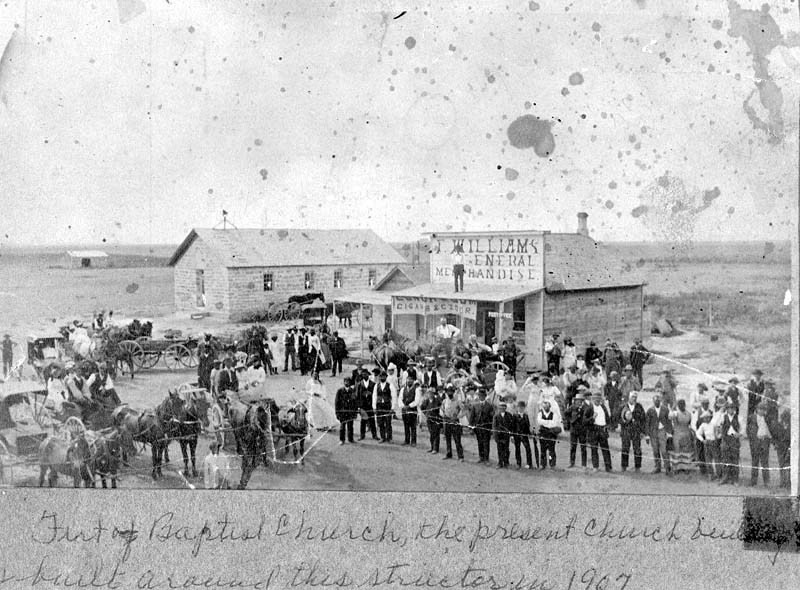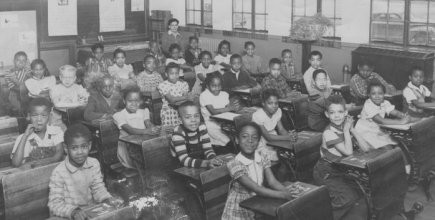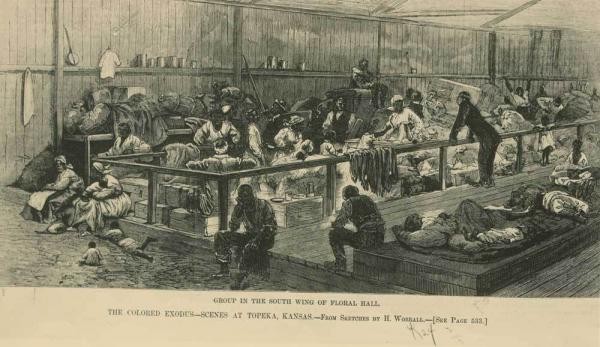St. John AME Church, Topeka Kansas
Introduction
Text-to-speech Audio
Images
St. John AME Church in Topeka, showcasing Gothic Revival-style architectural influences

African American community in Nicodemus, Kansas. These men, women, and children were part of Benjamin “Pap” Singleton's efforts to integrate freed men and ex-slaves into Kansas.

Segregated Monroe Elementary

1879 drawing in Harper's Weekly depicting the living quarters of "Exodusters," the name given to African Americans who migrated to Kansas in the late nineteenth century.

Backstory and Context
Text-to-speech Audio
Brief History of the African Episcopal Church
The church was officially established as the Methodist Church Mission in 1868. Before the founding of the Methodist Church Mission in 1868, the African Methodist Episcopal (AME) Church had been providing opportunities to African Americans since 1787. As the oldest Black organized institution in the United States, starting in Philadelphia, the Church grew out of the Free African Society (FAS). As a religious organization, it developed due to sociological differences as opposed to theological differences, making it one of the first to do so in the Western Hemisphere.
The Church’s mission continues to carry the spirit of the original FAS, which is to seek out and save the lost, and serve the needy. In concordance with this mission, AME has also endured as one of the major forerunners of education in the broader African-American community.1
History of the St. John AME Church
Beginning in 1868, the Methodist Church Mission (which was not officially affiliated with an organized religion) met in a small place known as “Alley Barn,” which is located between present-day Harrison and Van Buren Streets. Topeka wasn’t known for having a large African-American community at the time, and Alley Barn was located near the few homes of free African-American men and many ex-slaves who had migrated to Kansas. These ex-slaves typically came from Tennessee, which later led to the community serving Topeka’s “Tennessee Town” neighborhood.
For the first nine years, the Methodist Church Mission didn’t have a pastor. In 1877, Pastor John M. Wilkerson became the first minister, and that same year, he chartered the organization into the St. John AME Church. This made the church the first AME Church in Topeka, and Pastor Wilkerson stated in the church’s charter that is was formed for "Religious, Benevolent, and Charitable purposes, for the promotion of religion, and piety amongst mankind as taught by the Holy Bible, and as taught and practiced by the Methodist Episcopal Church of the United States."
On the corner of Second and Madison streets, the congregation bought land and began building their first church in 1879. Members also laid plans to build a different church on the corner of Seventh Street and Topeka Boulevard, and until this second church was completed in 1889, the congregation gathered in the basement of the first building.
By 1908, the first church was torn down with hopes for a new edifice. The architectural drawings of the new church are often associated with the work of Louis M. Wood, as these drawings resemble the current church today. Beginning in 1908, the new church underwent three major construction periods and was officially completed in 1926.
St. John AME Church and Social Movements
Although St. John AME Church's primary mission revolves around religious services, it has also played a significant role in various American social movements since 1868. The historic activities of the church are quite numerous, but they typically fall within three categories - Black Migration, Literacy, and Equality and Civil Rights.
Black Migration is most related to the Church’s earlier days, when ex-slaves and freed men in pursuit of freedom and a greater standard of living were moving in great numbers from southern states, particularly Tennessee, Kentucky, Missouri and Virginia.
Known as the Exodus Movement to Kansas, the St. John AME Church helped migrants and immigrants set up a livelihood in the budding city. In 1865, there were about 839 African Americans living in Topeka, though over the next few decades, hundreds more joined the community. This was, in part, due to the fact that Topeka was a “drop-off” point for ex-slaves.
Many stayed in Topeka with the help of the St. John AME Church, though hopes for a bright future were limited due to significant hardship. Furthermore, many of the migrants came to Topeka carrying a myriad of sicknesses and diseases, such as measles, pneumonia, pleurisy, consumption, and the bloody flux.
At the same time, the St. John AME Church had created Sunday schools and other social organizations to help people enhance their literacy skills. In the 1870s and ‘80s, St. John was a prominent host that discussed political, social, literary, and religious issues, with topics ranging from the destructive force of lawyers to resolutions declaring that Native Americans had suffered more than African Americans at the hands of the “White Race.”
In 1874, however, the relationship between educational segregation and Topeka was already on the rise, and leaders of St. John publicly expressed concerns that segregation in education, in public accommodations, and in common carries belied Kansas’s reputation for complete liberty and exact equality. As noted, Topeka was the epicenter of the Brown v. Board of Education case in 1954.
Other equality movements included the formation of the State Central Relief Committee in 1879 by Reverend Thomas W. Henderson, which oversaw relief efforts directed at immigrating freed men. A year earlier, Reverend Henderson was also involved with the formation of the first African-American press in Topeka.
The St. John AME Church would continue to be involved with major social, civic, and political issues of the day, including the Civil Rights Movement of the 1950s.2
